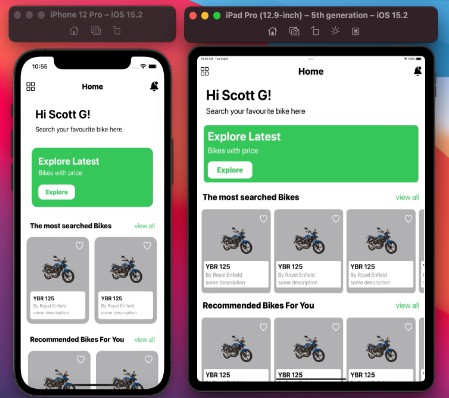URLRequestBuilder for Swift/Combine
A lightweight but powerful URLSession/URLRequest Builder implementation. This version is derived from the original RxSwift request builder concept found in the Builder demo application and has been explicitly designed for use in modern SwiftUI applications.
The RequestBuilder library consists of three main components: the request builder itself; session managers; and request interceptors.
RequestBuilder is also designed to make data mocking simple, easy, and painless.
Session Manager
Session Managers have a single purpose: To bind a base URL to a specific URLSession. They’re defined by the URLSessionManager protocol, but in most cases you can just use the handy BaseSessionManager provided by RequestBuilder.
import RequestBuilder
let base = URL(string: "https://randomuser.me/api")
let session = URLSession(configuration: URLSessionConfiguration.ephemeral)
let sessionManager = BaseSessionManager(base: base, session: session)
.set(decoder: myCustomDecoder)
.set(encoder: myCustomEncoder))
This example also shows how one can specify the default encoders and decoders used by the builder encoding and decoding functions. This comes in handy when, for example, all of the dates provided by a given API are in ISO8601 format and you don’t want to specifiy it each and every time.
Once you’ve created and saved your session manager, you can then use it to build a request and fetch information from the associated host server.
Request Builder
The Builder pattern makes it easy to build requests and then immediately proceed into decoding, processing, and then returning the desired data from the session’s dataTaskPubliser.
Just add the required path to the base, add query parameters or form or JSON data for the body, then request the data. Here’s a sample:
struct UserService {
public func list() -> AnyPublisher<[User], Error> {
sessionManager.request()
.add(path: "/api")
.add(queryItems: ["results" : "50", "seed": "998", "nat": "us"])
.data(type: UserResultType.self)
.map { $0.results }
.receive(on: DispatchQueue.main)
.eraseToAnyPublisher()
}
}
This particular generic data function decodes our data into a UserResultType. Now it’s a piece of cake to map out the array of users, make sure we’re on the main thread, and then return.
Data
Just need to grab the raw data? Or use a bespoke URL?
func image(for path: String) -> AnyPublisher<UIImage?, Never> {
sessionManager.request(forURL: URL(string: path))
.data()
.map(UIImage.init)
.replaceError(with: nil)
.receive(on: DispatchQueue.main)
.eraseToAnyPublisher()
}
We’ve got you covered.
Interceptors
Session Managers and Request Builders are pretty cool, but the entire concept really moves into overdrive once session managers are coupled with Interceptors.
Interceptors are thin wrappers around the session that manipulate the request and response data. They can, for example, be used to provide additional “default” data to all of the requests made to a given session.
let sessionManager1 = BaseSessionManager(base: base, session: session)
.interceptor(URLRequestInterceptorHeaders([
"User-Agent": "App(com.example; iOS 15.0.0) Swift 5.5",
"APP_VERSION": "1.16.0",
"APP_BUILD_NUM": "450",
"OS": "iOS",
"DEVICE_UUID": AppInfo.deviceID
]))
Call sessionManager.request() and all of the above values will automatically be added to the request, ready and waiting.
Interceptors can also be used to provide a standardized set of services for all requests made, like automatically logging requests and responses to the terminal; providing a default handler for mapping status codes; or adding a mechanism to automatically retry every request.
let sessionManager2 = BaseSessionManager(base: base, session: session)
.interceptor(URLRequestInterceptorMock())
.interceptor(URLRequestInterceptorLogging(mode: .debug))
.interceptor(URLRequestInterceptorStatusCodes())
.interceptor(URLRequestInterceptorRetry(1))
But one of the most powerful interceptors you can use is the very first one shown on the list, URLRequestInterceptorMock.
Mocking
When URLRequestInterceptorMock is added to the mix, Mocking becomes a first-class citizen in RequestBuilder. It’s easy to intercept any URL request and replace the data normally returned by the API with mock data.
Remember our original list() service function from above? Just add the following mock to the list and the next time it’s called you’ll receive a list containing empty data.
sessionManager.mock {
$0.add(path: "/api", data: UserResultType(results: []))
}
You could also accomplish the same thing by passing in the raw JSON and just let the regular decoding process do its work.
sessionManager.mock {
$0.add(path: "/api", json: "{ \"results\": [] }")
}
Need to mock some image data?
sessionManager.mock {
let image = UIImage(named: "User-JQ")?.pngData()
$0.add(path: "/api/portraits/med/men/16.png", data: image)
}
Want to test your view model’s error handling? Try one of the following:
sessionManager.mock {
$0.add(path: "/api", error: MyError.connection)
$0.add(path: "/api", status: 401)
}
Want to reset everything back to normal?
sessionManager.mocks?.reset()
It’s that simple.
With RequestBuilder, mocking happens at the bottom layer of the network stack. This makes it easy to do unit tests, integration tests, or even SwiftUI Previews without having to create extra protocols and inject mock services into your View Models.
This can dramtically increase your code coverage by letting you test more of the code that will actually be used in the production application.
Interceptor Configuration
RequestBuilder also allows for easy reconfiguration of any interceptor deep within the chain. Just provide the type you want to mutate. Consider.
sessionManager.configure(URLRequestInterceptorHeaders.self) {
$0.add(token, forHeader: "Authorization")
}
Now every API call made through that session includes the authorization token.
Note that this is how sessionManager.mock {} is implemented. It’s just a convenient shortcut for sessionManager.configure(URLRequestInterceptorMock.self) {}.
Installation
This is a BETA version of RequestBuilder. Most of the bits and pieces are nailed down and a lot of the rough edges have been filed off, but I make no guarantees that I won’t see a better way to accomplish something and start moving things around.
As such, RequestBuilder is currently only available as a Swift Package.
License
RequestBuilder is available under the MIT license. See the LICENSE file for more info.
Author
RequestBuilder was designed and written by Michael Long.
- LinkedIn: https://www.linkedin.com/in/hmlong/
- Twitter: @hmlco
Michael was also one of Google’s Open Source Peer Reward winners in 2021 for his work on Resolver.


